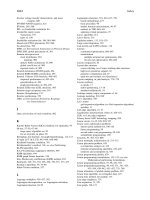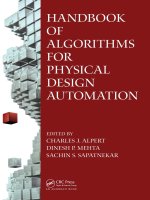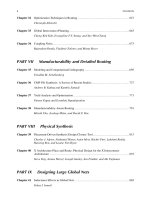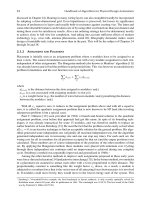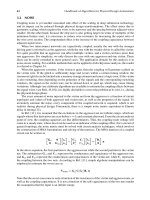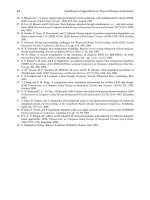Handbook of Materials for Product Design Part 1 pptx
Bạn đang xem bản rút gọn của tài liệu. Xem và tải ngay bản đầy đủ của tài liệu tại đây (1.04 MB, 80 trang )
iii
HANDBOOK OF
MATERIALS FOR
PRODUCT DESIGN
Charles A. Harper
Editor in Chief
Technology Seminars, Inc., Lutherville, Maryland
Third Edition
McGRAW-HILL
New York Chicago San Francisco Lisbon London Madrid
Mexico City Milan New Delhi San Juan Seoul
Singapore Sydney Toronto
00Front.a Page iii Thursday, May 31, 2001 10:25 AM
iv
Library of Congress Cataloging-in-Publication Data
Handbook of materials and product design / Charles A. Harper, editor in chief.
p. cm.
ISBN 0-07-135406-9
1. Materials—Handbooks, manuals, etc. 2. Engineering design—Handbooks, manuals,
etc. I. Harper, Charles A.
TA403.4.H365 2001
620.1'1—dc21 2001030028
CIP
Copyright © 2001 by McGraw-Hill, Inc. All rights reserved. Printed in the United
States of America. Except as permitted under the United States Copyright Act of
1976, no part of this publication may be reproduced or distributed in any form or
by any means, or stored in a data base or retrieval system, without the prior written
permission of the publisher.
1234567890DOC/DOC07654321
ISBN 0-07-135406-9
The sponsoring editor for this book was Kenneth McCombs and the
production supervisor was Pamela A. Pelton. It was set in Century
Schoolbook by J. K. Eckert & Company, Inc.
Printed and bound by R. R. Donnelley & Sons Company.
This book is printed on acid-free paper.
McGraw-Hill books are available at special quantity discounts to use as premiums
and sales promotions or for use in corporate training programs. For more informa-
tion, please write to the Director of Special Sales, Professional Publishing,
McGraw-Hill, Two Penn Plaza, New York, NY 10121-2298. Or contact your local
bookstore.
Information contained in this work has been obtained by The McGraw-Hill
Companies, Inc. ("McGraw-Hill") from sources believed to be reliable.
However, neither McGraw-Hill nor its authors guarantee the accuracy or
completeness of any information published herein, and neither McGraw-
Hill nor its authors shall be responsible for any errors, omissions, or dam-
ages arising out of use of this information. This work is published with the
understanding that McGraw-Hill and its authors are supplying information
but are not attempting to render engineering or other professional services.
If such services are required, the assistance of an appropriate professional
should be sought.
00Front.a Page iv Thursday, May 31, 2001 10:25 AM
E.1
ABOUT THE EDITOR
Charles A. Harper is President of Technology Seminars, Inc., of Lutherville, Maryland. He
is widely recognized as a leader in materials for product design, having worked and taught
extensively in this area. Mr. Harper is also Series Editor for the Materials Science and
Technology Series and the Electronic Packaging and Interconnection Series, both pub-
lished by McGraw-Hill. He has been active in many professional societies, including the
Society of Plastics Engineers, American Society for Materials, and the Society for the
Advancement of Materials Engineering, in which he holds the honorary level of Fellow of
the Society. He is a past President and Fellow of the International Microelectronics and
Packaging Society. Mr. Harper is a graduate of the Johns Hopkins University, Baltimore,
Maryland, where he has also served as Adjunct Professor.
99About Page 1 Thursday, May 31, 2001 10:25 AM
v
CONTENTS
Contributors
xiii
Preface
xi
Chapter 1. Ferrous Metals 1.1
1.1 Introduction 1.1
1.2 The Structure of Iron 1.2
1.3 Steelmaking 1.6
1.4 Carbon and Alloy Steels 1.11
1.5 Selection of Alloy Steels 1.29
1.6 Selection and Specification 1.43
1.7 Welding Ferrous Metals 1.61
1.8 Summary 1.91
References 1.92
Chapter 2. Aluminum and Its Alloys 2.1
2.1 Introduction 2.1
2.2 Alloy and Temper Designation System 2.5
2.3 Physical Properties 2.27
2.4 Mechanical Properties 2.41
2.5 Corrosion Resistance 2.92
2.6 Product Forms 2.107
2.7 Fabrication 2.129
2.8 Joining 2.138
2.9 Finishes 2.162
2.10 Glossary 2.174
References 2.177
Chapter 3. Titanium 3.1
3.4
3.2
3.12
3.3
Properties 3.16
3.4
Corrosion and Corrosion Resistance 3.27
3.5
Alloys for Cryogenic Applications 3.33
3.6
Titanium Alloys for High-Temperature Applications 3.34
3.7
Casting Alloys 3.41
3.8
Precipitate and Dispersoid Strengthened Alloys 3.43
3.9
Wrought Alloy Processing 3.44
References 3.60
00Front.b Page v Thursday, May 31, 2001 10:26 AM
3.1
Basic Metallurgy
Alloy Classification and Overview
Introduction
3
.
1
vi
HANDBOOK OF MATERIALS FOR PRODUCT DESIGN
Chapter 4. Plastics 4.1
4.1 Introduction 4.1
4.2 The Nature of Plastics 4.6
4.3 Polymer Structures and Polymerization Reactions 4.8
4.4 Plastic-Processing Methods and Design Guidelines 4.10
4.5 Thermosetting Plastics 4.18
4.6 Thermoplastics 4.34
4.7 Glass-Fiber-Reinforced Thermoplastics 4.75
4.8 Plastic Films and Tapes 4.76
4.9 Plastic Surface Finishing 4.78
4.10 Material Selection 4.80
References 4.106
Chapter 5. Composite Materials and Processes 5.1
5.1 Introduction 5.1
5.2 Material Systems 5.5
5.3 Ply Orientations, Symmetry, and Balance 5.25
5.4 Quasi-isotropic Laminate 5.31
5.5 Analysis 5.32
5.6 Composite Failure and Design Allowables 5.35
5.7 Composite Fabrication Techniques 5.40
5.8 Analysis 5.76
5.9 Design of Composite Structures 5.78
5.10 Damage Tolerance 5.85
5.11 Composite Repairs 5.88
5.12 Adhesive Bonding and Mechanical Fastening 5.91
5.13 Environmental Effects 5.96
5.14 Composite Testing 5.98
5.15 Safety Issues with Composite Materials 5.103
References 5.105
Chapter 6. Part 1: Natural and Synthetic Rubbers 6.1
6.1 Historical 6.1
6.2 Properties of Polymers 6.3
6.3 General-Purpose Rubbers 6.5
6.4 Specialty Rubbers 6.7
6.5 Thermoplastic Elastomers 6.9
6.6 Characterizing Heat and Oil Resistance 6.10
6.7 Other Properties 6.15
6.8 Compounding Rubber 6.28
References 6.31
Suggested Readings 6.31
00Front.b Page vi Thursday, May 31, 2001 10:26 AM
CONTENTS
vii
Chapter 6. Part 2: Elastomeric Materials and Processes 6.35
Introduction 6.35
Thermoplastic Elastomers (TPEs) 6.35
Polyurethane Thermoplastic Elastomers (TPUs) 6.45
Polyamides 6.56
Melt Processable Rubber (MPR) 6.58
Thermoplastic Vulcanizate (TPV) 6.60
Synthetic Rubbers (SRs) 6.67
Natural Rubber (NR) 6.83
Conclusion 6.85
References 6.85
Chapter 7. Ceramics and Ceramic Composites 7.1
7.1 Introduction 7.1
7.2 Ceramic Fabrication 7.3
7.3 Surface Properties of Ceramics 7.6
7.4 Thermal Properties of Ceramic Materials 7.9
7.5 Mechanical Properties of Ceramic Substrates 7.14
7.6 Electrical Properties of Ceramics 7.22
7.7 Metallization of Ceramic Substrates 7.29
7.8 Ceramic Materials 7.40
7.9 Composite Materials 7.49
7.10 Forming Ceramics and Composites to Shape 7.57
References 7.60
Chapter 8. Inorganic Glasses 8.1
8.1 Commercial Glass Families 8.1
8.2 Special Glasses 8.37
8.3 Glass Making I—Glass Melting 8.82
8.4 Glass Making II—Glass Forming 8.102
8.5 Annealing and Tempering 8.119
8.6 Glass Fiber 8.145
8.7 Optical Communications Fiber 8.163
8.8 Notes and Acknowledgments 8.170
References 8.170
Bibliography 8.172
Chapter 9. Coatings and Finishes 9.1
9.1 Introduction 9.1
9.2 Environment and Safety 9.5
9.3 Surface Preparation 9.6
9.4 Coating Selection 9.12
9.5 Coating Materials 9.22
9.6 Application Methods 9.41
00Front.b Page vii Thursday, May 31, 2001 10:26 AM
6.9
6.10
6.11
6.12
6.13
6.14
6.15
6.16
6.17
viii
HANDBOOK OF MATERIALS FOR PRODUCT DESIGN
9.7 Curing 9.55
9.8 Summary 9.58
References 9.59
Chapter 10. Metallic Finishes and Processes 10.1
10.1 Fundamentals 10.1
10.2 Metallic Finishes and Processes 10.2
10.3 Aluminum Coatings 10.5
10.4 Cadmium Coatings 10.27
10.5 Chromium Coatings 10.35
10.6 Copper Coatings 10.44
10.7 Copper Alloy Coatings 10.50
10.8 Tin and Tin Alloy Coatings 10.54
10.9 Silver Coatings 10.63
References 10.66
Chapter 11. Plastics Joining Materials and Processes 11.1
11.1 Introduction 11.1
11.2 General Types of Plastic Materials 11.2
11.3 Types of Plastic Joining Processes 11.4
11.4 Direct Heat Welding 11.5
11.5 Indirect Heating Methods 11.20
11.6 Friction Welding 11.25
11.7 Solvent Cementing 11.37
11.8 Methods of Mechanical Joining 11.40
11.9 Recommended Assembly Processes for Common Plastics 11.50
11.10 More Information on Joining Plastics 11.61
References 11.62
Chapter 12. Plastics and Elastomers as Adhesives 12.1
12.1 Introduction to Adhesives 12.1
12.2 Design and Test of Adhesive Joints 12.15
12.3 Surface Preparation 12.32
12.4 Types of Adhesives 12.60
12.5 Selecting an Adhesive 12.82
12.6 Effect of the Environment 12.95
12.7 Processing and Quality Control of Adhesive Joints 12.107
References 12.119
Chapter 13. Testing of Materials 13.1
13.1 Introduction 13.1
Typical Paint and Coating Test Program 13.6
13.2 Chemical Characterization 13.14
00Front.b Page viii Thursday, May 31, 2001 10:26 AM
CONTENTS
ix
13.3 Thermal Analysis 13.24
13.4 Thermal Testing 13.32
13.5 Mechanical Testing 13.36
13.6 Miscellaneous Testing 13.44
Recommended Readings 13.54
References 13.54
Chapter 14. Materials Recycling 14.1
14.1 Introduction 14.1
14.2 Collection of Materials for Recycling 14.18
14.3 Ferrous Metal Recycling 14.22
14.4 Aluminum Recycling 14.26
14.5 Recycling of Other Nonferrous Metals 14.29
14.6 Glass Recycling 14.29
14.7 Paper Recycling 14.32
14.8 Plastics Recycling 14.50
14.9 Recycling of Rubber 14.97
14.10 Recycling of Textiles 14.98
14.11 Recycling of Wood 14.99
References 14.100
Index I.1
00Front.b Page ix Thursday, May 31, 2001 10:26 AM
xi
CONTRIBUTORS
Thomas A. Andersen
Northrop-Grumman Corporation, Baltimore, Maryland
(C
HAP
. 10)
R. J. Del Vecchio
Technical Consulting Services, Fuquay-Varina, North Carolina
(C
HAP
. 6)
Simon Durham
Pratt & Whitney Canada, Longuevil, Quebec, Canada
(C
HAP
. 3)
J. Donald Gardner
Northrup Grumman Electronic Sensors and Systems Sector, Columbia,
Maryland
(C
HAP
. 1)
Carl P. Izzo
Industrial Paint Consultant, Export, Pennsylvania
(C
HAP
. 9)
J. Randolph Kissell
TGB Partnership, Hillsborough, North Carolina
(C
HAP
. 2)
James Margolis
Consultant, Montreal, Quebec, Canada
(C
HAP
. 6)
Perry L. Martin
Martin Testing Laboratories, Yuba City, California, www.martintesting.com
(C
HAP
. 13)
Robert Ohm
Uniroyal Chemical, Naugatuck, Connecticut
(C
HAP
. 6)
Stanley T. Peters
Process Research, Mountain View, California, www.process-research.com
(C
HAP
. 5)
Edward M. Petrie
ABB Power T & D Company, Inc., Raleigh, North Carolina
(C
HAPS
. 11, 12)
Jordon I. Rotheiser
Rotheiser Design, Inc., Highland Park, Illinois
(C
HAP
. 4)
Susan E.M. Selke
School of Packaging, Michigan State University, East Lansing, Michigan
(C
HAP
. 14)
Jerry E. Sergent
TCA Inc., Corbin, Kentucky
(C
HAP
. 7)
Thomas P. Seward III
New York State College of Ceramics, Alfred University, Alfred, New York
(C
HAP
. 8)
Arun Varshneya
New York State College of Ceramics, Alfred University, Alfred, New York
(C
HAP
. 8)
Steven Yue
McGill University, Montreal, Quebec, Canada
(C
HAP
. 3)
00Front.b Page xi Thursday, May 31, 2001 10:26 AM
xiii
PREFACE
While the role of materials has always been important in product design, materials are now often the
keystones for successful products in our modern world of high technology. In fact, it might even be
said that materials are the critical limiting factor for achieving the high performance and reliability
demanded of today’s products. Next generation’s products usually require new or improved materi-
als, and necessity often becomes the mother of invention. Materials scientists always rise to meet the
need.
Success in achieving outstanding materials is not adequate, however. Since most prod-
uct designers are mechanical or electrical engineers, and since materials are chemical,
these significantly different technical languages lead to a critical knowledge and under-
standing gap. Successful product design requires, first, bridging this technical language
barrier gap and, second, providing the product designer with the information, data, and
guidelines necessary to select the optimum material for a given product design. It is the
purpose of this
Handbook of Materials for Product Design
to provide both an understand-
ing of the many classes of materials that the product designer has available to him, and the
information, data, and guidelines that will lead the product designer to the best choice of
materials for his specific product. Toward this end, this book has been prepared as a thor-
ough sourcebook of practical data for all ranges of interests. It contains an extensive array
of materials properties and performance data, presented as a function of the most impor-
tant product variables. In addition, it contains very useful reference lists at the end of each
chapter and a thorough, easy-to-use index.
The chapter organization of this
Handbook of Materials for Product Design
is well
suited for reader convenience. The initial three chapters deal with metal materials—first,
the important ferrous metals, then second, the broadly used aluminum metals and alloys,
and third, metals other than those covered in the first two chapters. The second set of three
chapters covers polymeric materials first, the all-important group of plastic materials,
then, second, that specially reinforced group of plastics known as
composites,
and third,
that important group of rubbery polymeric materials known as
elastomers
. Next come two
chapters on the two major groups of nonmetallic, inorganic materials, namely, ceramics
and glasses. These are followed by two chapters on finishes, first organic finishes and
paints, and second, electrodeposited or electroplated metallic finishes.
Following all of the above chapters on specific groups of materials are two chapters on
the always critical and often difficult areas of bonding materials. First is a chapter on the
joining of plastics, with explanations of the various processes and their trade-offs. Next
comes a very practical and useful chapter on the many adhesive bonding materials, tech-
niques, and processes, along with their trade-offs.
The final two chapters in the book are both increasingly important and critical in mod-
ern product design applications. First is a chapter on materials testing and reliability, and
second is a chapter on material recycling. These are especially important, since they affect
not only optimum product design but also environmental and even legal issues.
The result of these presentations is an extremely complete and comprehensive single
reference text—a must for the desk of anyone involved in product design, development,
and application. This
Handbook of Materials for Product Design
will also be invaluable
for every reference library.
00Front.b Page xiii Thursday, May 31, 2001 10:26 AM
xiv
HANDBOOK OF MATERIALS FOR PRODUCT DESIGN
As will be evident from a review of the subject and author listings, I have had the good
fortune to be able to bring together a team of outstanding chapter authors, each with a
great depth of experience in his or her field. Together, they offer the reader a base of
knowledge as perhaps no other group could. Hence, I would like to give special credit to
these authors in this preface.
It is my hope and expectation that this
Handbook of Materials for Product Design
will
serve its readers well. Any comments or suggestions will be welcomed.
Charles A. Harper
Technology Seminars, Inc.
Lutherville, Maryland
00Front.b Page xiv Thursday, May 31, 2001 10:26 AM
1.1
1
Ferrous Metals
*
J. Donald Gardner
Northrup Grumman Electronic Sensors and Systems Sector
Columbia, Maryland
1.1 Introduction
One major technical advancement of the early Greek period was the
widespread use of iron. Furnaces were developed that could reach the
high melting temperature of that metal. Iron technology had spread
throughout the classical world by about 500
B
.
C
. Adding small
amounts of carbon to iron as it was hammered over a charcoal fire in-
augurated early steels. Mining became well developed and included
the use of pumps to keep mines from flooding. Technology also ad-
vanced weaponry with the development of catapults, better swords,
and body armor.
The main reasons for the popularity of steel are the relatively low
cost of making, forming, and processing it; the abundance of its two
raw materials (iron ore and scrap); and its unparalleled range of me-
chanical properties. More than any other material, the quality of life,
in many respects, has improved on the planet as the quality of steel
has improved.
Initially, tools of iron to were used to form many of the other needed
goods. Eventually, this was followed by the Industrial Revolution and
the mechanization of farms. Machine tools and other equipment made
of iron and steel changed the economy of both city and farm.
Steel is the most widely used material for building the world’s infra-
structure. It is used to fabricate everything from pins to skyscrapers.
In addition, the tools required to build and manufacture such articles
are also made of steel.
* With special credit to
Stephen G. Konsowski,
Consultant, Glen
Burnie, Maryland.
01Gardner Page 1 Wednesday, May 23, 2001 9:49 AM
1.2 Chapter 1
Today, most of the finished steel produced in the United States is
shipped to five domestic markets. The automotive industry takes the
greatest share, about 20 percent. Almost 20 percent goes into the
warehouses of steel service centers, where the metal is sold as bar
stock or plate, or it is processed to order for specific industrial applica-
tions. Some 15 percent is used, either directly or indirectly, for con-
struction. Cans and other containers take about six percent of the
production of finished steel. Another six percent goes directly from the
mill to farm and electrical equipment manufacturers.
The steel industry, like many of the metal industries, offers a high
degree of standardization. Because of the degree of standardization, a
designer need only be concerned with specifying the proper alloy, prod-
uct form, and heat treatment and can be less concerned with the ulti-
mate supplier of the steel. Specifications for steel products, as well as
testing procedures, are normally included in the general standard sys-
tems of most industrial countries. Such standardization still does not
exist for nearly all forms of organic materials.
1.2 The Structure of Iron
1.2.1 Phase Diagrams
1
The term
phase
is variously defined in the dictionary. The chemical
definition, which applies for this chapter, is
a solid, liquid, or gaseous
homogeneous form of matter existing as a distinct part of a heteroge-
neous system.
One of the simplest and most common examples of this definition is
water (H
2
0). The H
2
0 chemical compound is a solid phase (ice) at tem-
peratures at or below 0°C (32°F). It is a liquid phase (water) between
the temperatures of 0°C (32°F) and 100°C (212°F) at sea level pres-
sure, and a gaseous phase (steam) at a temperature of 100°C (212°F)
or above.
Metals and alloys may also exist as solid, liquid, and gaseous
phases. With one notable exception (mercury), metals exist in their
solid phase at room temperatures. A few metals and alloys do change
from solid to liquid.
1.2.2 Phase Changes
In most simple substances, the phases are very straightforward: solid,
liquid and gas, as described above. This is less likely to be true for all
metals and alloys. Some pure metals can exist as more than one phase
within their solid state, depending on temperature. Alloys vary widely
and may contain several phases within their solid state.
01Gardner Page 2 Wednesday, May 23, 2001 9:49 AM
Ferrous Metals 1.3
The commonly accepted system of designating the various phases
utilizes the chemical symbol of the element and letters of the Greek al-
phabet. See Fig. 1.1 for the iron-carbon phase diagram.
Figure 1.1 Major groups in the AISI-SAE designation system.
2
01Gardner Page 3 Wednesday, May 23, 2001 9:49 AM
1.4 Chapter 1
Fluid at temperatures near that of boiling water, most metals and
alloys change from their solid to their liquid phases at considerably el-
evated temperatures. Many metals undergo this change within the
range of 540 to 1540°C (1000 to 2800°F). At still higher temperatures,
metals and alloys are converted into gaseous phases.
In heat processing of metals, the transition from the solid to the gas-
eous phase (sublimation) sometimes must be considered—most nota-
bly in vacuum processing of metals that have relatively low vapor
pressures. An outstanding example of sublimation is heat treating of
stainless steels in a vacuum furnace, under which condition the loss of
chromium can be excessive when elevated temperature and a hard
vacuum (a pressure of 10
–6
torr) are used.
Definitions of terms related to metallurgical phase changes are:
1.
Eutectic.
(1) An isothermal (constant temperature) reversible reac-
tion in which a liquid solution is converted into two or more inti-
mately mixed solids on cooling, the number of solids formed being
the same as the number of components in the system. (2) An alloy
having the composition indicated by the eutectic point on an equi-
librium diagram. (3) An alloy structure of intermixed solid constit-
uents formed by a eutectic reaction.
2.
Eutectoid.
(1) An isothermal reversible reaction in which a solid so-
lution is converted into two or more intimately mixed solids on
cooling, the number of solids formed being the same as or the num-
ber of components in the system. (2) An alloy having the composi-
tion indicated by the eutectoid point on an equilibrium diagram.
(3) An alloy structure of intermixed solid constituents formed by a
eutectoid reaction.
3.
Intermetallic compound.
An intermediate phase in an alloy system
having a narrow range of homogeneity and relatively simple sto-
ichiometric proportions. The nature of the atomic binding can be of
various types, ranging from metallic to ionic.
4.
Peritectic.
An isothermal reversible reaction in which a liquid
phase reacts with a solid phase to produce a single (and different)
solid phase on cooling.
5.
Peritectoid.
An isothermal reversible reaction in which a solid
phase reacts with a second solid phase to produce a single (and dif-
ferent) solid phase on cooling.
1.2.3 Crystallography of Iron
Allotropy
is the nature of a solid metal to assume more than one lat-
tice arrangement (crystallographic structure), depending on the tem-
01Gardner Page 4 Wednesday, May 23, 2001 9:49 AM
Ferrous Metals 1.5
perature and energy level. Several of the pure metals are allotropic. In
some instances, the allotropic characteristic is of minor importance in
relation to heat processing. For iron and titanium, however, their allo-
tropic characteristics are extremely important, serving as the mecha-
nism that allows development of specific properties by means of heat
treatment.
The simplest forms of phase diagrams are those that represent pure
metals. These are straight lines, usually beginning at room tempera-
ture and extending up to or above the metals’ melting temperatures.
The phase diagram for pure iron generally is considered the most im-
portant, because iron is the major constituent of all steels. At room
temperature, the iron atoms are body-centered cubic (bcc) structure.
This phase is designated
alpha iron.
Iron in this phase is attracted to
a magnet. When the temperature reaches 770°C (1418°F) on heating,
the bcc alpha iron structure becomes nonmagnetic; this is not consid-
ered to be a phase change.
When the temperature reaches 912°C (1674°F), the atom arrange-
ment changes to the face-centered cubic (fcc) phase, which is desig-
nated
gamma iron.
This phase change is accompanied by a decrease in
volume and absorption of heat (heat of transformation). The fcc phase
prevails until the temperature reaches 1394°C (2541°F), at which
point a third modification takes place—the atom arrangement reverts
back to bcc and is denoted as
delta iron.
Although the alpha and delta
phases are similar, both being bcc, they are separately termed, be-
cause one exists below the gamma range, while the other exists above
the gamma range. The delta phase melts at 1538°C (2800°F).
For most heat processing operations of ferrous alloys, the portion
above the gamma range is not important. The lattice modifications of
pure iron are reversible, because they are temperature dependent;
that is, when the liquid phase is cooled to 1538°C (2800°F), it first
freezes as delta iron (bcc) phase, then changes to gamma iron (fcc) at
1394°C (2541°F).
When two or more metals are combined in their liquid states then
allowed to solidify, a wide array of events may take place. In many
instances, because two metals are totally insoluble in each other, the
solidified mass is not an alloy but simply a mixture. A notable exam-
ple of a metal mixture is lead in iron (or steel). Lead is completely in-
soluble in iron; if the lead is added to molten iron, it solidifies as a
dispersion of lead particles in the solidified iron and is thus a true
mixture.
At the opposite extreme, two metals may be completely soluble in
each other in the liquid phase as well as in the solid phase. A notable
example of such an alloy system is copper and nickel. In other in-
stances, the solid solubility of one metal in another may vary greatly
01Gardner Page 5 Wednesday, May 23, 2001 9:49 AM
1.6 Chapter 1
with temperature. Numerous phases may be formed, depending to a
great extent on cooling rate. In these cases, when one metal dissolves
in another, the result is an alloy that is sharply segregated from a
mixture, such as lead in iron as described above. Nonmetals dis-
solved in metals may form alloys such as steel, an alloy of iron and
carbon.
Also, when iron cools from the gamma phase (fcc) to the alpha phase
(bcc), there is an evolution of heat. The alpha phase is constant to
room temperature and below. An isotherm (constant temperature) oc-
curs on the phase diagram, because heat is evolved on cooling and ab-
sorbed on heating during phase changes and at the magnetic change.
1.3 Steelmaking
2
1.3.1 Process Metallurgy of Steelmaking
Steel is by definition an alloy of iron and carbon, but this statement
must be qualified by placing limits on carbon content. When iron-car-
bon alloys have less than 0.005% carbon present at room temperature,
they are considered to be pure iron. Pure iron is soft, ductile, and rela-
tively weak. It is not normally used as an engineering material be-
cause of its low strength, but it is used for special applications such as
magnetic devices and enameling steels (steels that are glass coated,
like bathtubs). From the commercial standpoint, steels have a low car-
bon limit of approximately 0.06% carbon. On the other end of the car-
bon-content scale, iron-carbon alloys with more than approximately
2% by weight of carbon are considered to be cast irons. Above this car-
bon level, casting is about the only way that a useful shape can be
made from the alloy, since the high carbon makes the iron alloy too
brittle for rolling, forming, shearing, or other fabrication techniques.
Thus, steels are alloys of iron and carbon with carbon limits between
approximately 0.06 and 2.0%.
Typically, the carbon content in pig iron may be 4 or 5%, which is too
high to use as a steel. In addition to the high carbon content, the pig
iron may contain high amounts of silicon, sulfur, phosphorus, and
manganese, as well as physical inclusions of nonmetallic materials
from the ore.
1.3.1.1 Refining processes.
The early Bessemer furnaces used in the
purification of pig iron to steel employed a sustained blast of air in the
molten iron. Today, the purification of pig iron into steel is accom-
plished in three basic processes.
01Gardner Page 6 Wednesday, May 23, 2001 9:49 AM
Ferrous Metals 1.7
1. Basic oxygen furnace
2. Open hearth furnace
3. Electric furnace
Basic oxygen furnace.
The basic oxygen furnace was introduced into
the United States in the 1960s. This process for making steel involves
charging a large ladle-shaped vessel with about 25% scrap and 75%
molten pig iron. Oxygen lances are lowered into the melt, and blowing
is initiated. Large amounts of pressurized oxygen are introduced into
the molten charge. The heat of this reaction provides the heat for the
process; the furnace is not externally heated. When the charge is suffi-
ciently blown (the carbon content of the charge is reduced to the de-
sired level), the oxygen lances are withdrawn, and the furnace is
tipped to pour the molten charge. Refining times are very short, and
sophisticated computer equipment is used to analyze the composition
of the charge; 300 tons of steel can be refined in 25 min.
Obviously, the short refining time of the basic oxygen furnace (BOF)
makes it the process of choice and economic necessity for competitive
steel mills. Since the 1960s, there has been an evolutionary change in
the U.S. steel industry to make all large-tonnage steel products in ba-
sic oxygen furnaces
Open hearth furnaces.
Open hearth furnaces have been the workhorse
of the steel industry since the turn of this century. They can produce
as much as 450 tons of steel in a single batch, and they have been used
for the bulk of steel production in the United States since the phase-
out of the Bessemer process. The starting material for the open hearth
furnace is molten pig iron that is transported to the furnace in hot
metal cars and scrap (possibly equal amounts). These starting materi-
als are charged into the hearth, which is really nothing but a shallow
rectangular pool of molten metal. Large quantities of air are supplied
to the area over the molten pool to produce oxidation of the carbon in
the material to be refined. Oxygen lances are also placed into the pool
to help reduce the carbon level. When the charge has been refined to
the desired carbon level, the slag that forms on the top of the pool is
tapped, and the refined steel is tapped into a ladle. Subsequently, the
metal in the ladle is poured into ingot molds. A charge of 300 tons may
take 8 hr of refining before it is ready to pour.
Electric furnaces.
Electric furnaces are usually charged with scrap,
and melting is accomplished by establishing an electric arc between
carbon electrodes that are lowered in proximity to the charge. These
furnaces take massive amounts of energy, but they do not compare in
complexity and enormity with the open hearth equipment. Refining
times are shorter, and the furnace is pivoted for pouring. Electric fur-
01Gardner Page 7 Wednesday, May 23, 2001 9:49 AM
1.8 Chapter 1
naces tend to produce cleaner steels than open hearth furnaces. Until
the 1970s, these furnaces were mostly used for specialty alloys, such
as tool steels, bearing steels, and stainless steels. These furnaces are
also used in mini-mills that are often dedicated to limited groups of
steel products.
1.3.1.2 Clean steels.
With increased emphasis on reliability, many in-
dustries are specifying that steels for critical parts be made by special
melting practices. Many strength-of-materials studies have shown, for
example, that the fatigue life and toughness of steels are directly pro-
portional to the size and volume fraction of nonmetallic inclusions in
the steel. These inclusions are usually oxides, silicates, sulfides, or
aluminas that form during conventional melting and refining. The in-
clusion rating of a piece of steel can be measured by sawing a thin
slice from the end of a steel shape and etching it in an acid. A dirty
steel will show pits when the inclusions are etched away by the acid.
There are also micro-cleanliness standards for steels that measure in-
clusion ratings by microscopic examination of a polished sample from
a steel shape. These inclusion ratings can be added to a steel purchas-
ing specification so that a designer has the option of specifying steel of
special cleanliness.
There are two major techniques and a number of options in each
category:
Vacuum melting or remelting
■
Vacuum degassing (VD)
■
Vacuum arc remelting (VAR)
■
Vacuum induction melting (VIM)
■
Electron beam refining (EBR)
Chemical reaction
■
Argon oxygen decarburization (AOD)
■
Electroslag remelting (ESR)
■
Ladle refining (LR)
Vacuum refining.
In vacuum refining, steel is usually melted in a basic
oxygen or electric furnace and, by some secondary technique, the steel
is exposed to a vacuum while it is molten. Dissolved gases rise to the
surface of the melt and go off in the vacuum. With sufficient stirring
and mixing, solid inclusions can also be vaporized and drawn away by
the vacuum. The differences between the various processes involve
how melting and stirring are achieved. Vacuum degassing (VD) is usu-
01Gardner Page 8 Wednesday, May 23, 2001 9:49 AM
Ferrous Metals 1.9
ally accomplished by lance stirring molten steel and pouring it into in-
gots in a large evacuated enclosure. Vacuum arc remelting (VAR), the
most popular technique, involves casting of steel from the BOF or elec-
tric furnace into cylindrical ingots. A stub shaft is welded to these in-
gots, and the ingot is remelted in a vacuum by establishing an arc
between the ingot (electrode) and a water-cooled copper mold. The in-
got becomes a giant welding electrode. This process is very effective in
removal of inclusions because it is very energetic. Every drop of the in-
got is exposed to vacuum as the droplets transfer in the arc.
Vacuum induction melting (VIM) is a process that is used to melt
solid scrap or liquid charges. The charge is placed in a crucible and
heated by high-frequency induced currents. This produces convection
current mixing of the melt. The entire crucible is in the vacuum, and
ingots are also cast in the vacuum.
In electron beam refining, molten metal is poured down a tundish
(chute) into an ingot mold. The tundish and mold are in a vacuum. As
the metal flows down the tundish, it is subjected to an electron beam
that vaporizes impurities so that they can be removed as vapors in the
vacuum.
The processes grouped under chemical reaction are different from
the vacuum refining mechanism in that impurities are removed by re-
action with some species introduced into the melt; they are not in vac-
uum. In the AOD process, argon and oxygen are introduced into a
crucible containing a molten heat from an electric furnace or BOF. The
oxygen reduces carbon level (decarburization), sulfides, and other im-
purities. The argon causes significant stirring to disperse oxides and
make them smaller. The argon also promotes removal of dissolved
gases.
Electroslag refining.
Electroslag refining is similar to VAR without the
vacuum. A VIM or electric furnace melt is cast into remelt ingots.
These ingots have a stub welded to them, and they are made into elec-
trodes for arc remelting in a water-cooled copper mold. Purification is
accomplished when the melting metal from the ingot passes through a
molten flux that acts like a welding electrode slag to remove impuri-
ties. Shrinkage voids are minimal in ESR ingots.
1.3.1.3 Steel terminology.
The selection of steels requires consultation
on property information and supplier information on availability. If
the designer is to make any sense out of handbook information, it is
necessary to become familiar with the terms used to describe mill pro-
cessing operations. There are so many terms that it can be very con-
fusing. The following is a tabulation of steel product terms and what
they mean.
01Gardner Page 9 Wednesday, May 23, 2001 9:49 AM
1.10 Chapter 1
Carbon steel
Steels with carbon as the principal hardening agent. All other
alloying elements are present in small percentages, with manganese being
limited to 1.65% maximum, silicon to 0.60% maximum, copper to 0.60% maxi-
mum, and 0.05% maximum for sulfur and phosphorus.
Alloy steels
This term can refer to any steel that has significant additions of
any element other than carbon but, in general usage, alloy steels are steels
with total alloy additions of less than about 5%. They are used primarily for
structural applications.
Rimmed
Slightly deoxidized steels that solidify with an outer shell on the in-
got that is low in impurities and very sound. These steels can retain a good fin-
ish even after severe forming because of the surface cleanliness.
Killed
Strongly deoxidized, usually by chemical additions to the melt. These
steels have less segregation than rimmed steels. The mechanical properties
are more predictable than commercial and merchant-grade steels.
Concast
Steel produced in a continuous steel casting facility. These steels
are deoxidized (usually with aluminum additions).
Galvanized
Zinc-coated steel products. The zinc is applied by hot dipping.
Galvannealed
Zinc-coated and heat-treated steel. There are usually paint-
adhesion problems with galvanized steels. The heat treatment given to gal-
vannealed steels creates an oxide layer that allows better paint adhesion.
Sheet
Rolled steel primarily in the thickness range of 0.010 to 0.250 in. (0.25
to 6.4 mm) thick and with a width of 24 in. (610 mm) or more.
Bar
Hot- or cold-rolled rounds, squares, hexes, rectangles, and small shapes.
Round bars can be as small as 0.25 in. (6.4 mm); flats can have a minimum
thickness of 0.203 in. (5.0 mm); shapes have a maximum dimension less than
3 in. (76 mm).
Coil
Rolled steel in the thickness range of sheet or strip.
Flat wire
Small hot- or cold-rolled rectangles often made by cold-reducing
rounds to rectangular shape.
Wire
Hot- or cold-drawn coiled rounds in varying diameters, usually not ex-
ceeding 0.25 in. (6.4 mm).
Shapes
Hot-rolled I-beams, channels, angles, wide-flange beams, and other
structural shapes. At least one dimension of the cross section is greater than 3
in. (76 mm).
Tin plate
Cold-rolled steel with a usual thickness range of 0.005 to 0.014 in.
(0.1 to 0.4 mm). It may or may not be tin coated.
Free machining
Steels with additions of sulfur, lead, selenium, or other ele-
ments in sufficient quantity that they machine more easily than untreated
grades.
01Gardner Page 10 Wednesday, May 23, 2001 9:49 AM
Ferrous Metals 1.11
Drawing quality
Hot- or cold-rolled steel specially produced or selected to
satisfy the elongation requirements of deep drawing operations.
Merchant quality
Steels with an M suffix on the designation intended for non-
structural applications. A low-quality material.
Commercial quality
Steels produced from standard rimmed, capped, concast,
or semikilled steel. These steels may have significant segregation and varia-
tion in composition, and they are not made to guaranteed mechanical property
requirements (most widely used grade).
H Steels
Steels identified by an H suffix on the designation and made to a
guaranteed ability to harden to a certain depth in heat treatment.
B Steels
Steels with small boron additions as a hardening agent. These steels
are identified by a B inserted between the first two and last two digits in the
four-digit identification number (xx B xx).
Pickling
Use of acids to remove oxides and scale on hot-worked steels.
Temper rolling
Many steels will exhibit objectionable strain lines when drawn
or formed. Temper rolling involves a small amount of roll reduction as a final
operation on annealed material to eliminate stretcher strains. This process is
sometimes used to improve the surface finish on a steel product.
Temper
The amount of cold reduction in rolled sheet and strip.
E Steels
Steels with an E prefix on the four-digit designation are melted by
electric furnace.
1.4 Carbon and Alloy Steels
2
1.4.1 Basic Definitions of Carbon and Alloy
Steels
Carbon steels are simply alloys of iron and carbon, with carbon as the
major strengthening agent. The American Iron and Steel Institute
(AISI) defines carbon steels as steels with up to 2% carbon and only re-
sidual amounts of other elements except those added for deoxidation
(for example, aluminum), with silicon limited to 0.6%, copper to 0.6%,
and manganese to 1.65%. Other terms applied to this class of steels
are plain carbon steels, mild steels, low-carbon steels, and straight
carbon steels. These steels make up the largest fraction of steel pro-
duction. They are available in almost all product forms: sheet, strip,
bar, plates, tube, pipe, wire. They are used for high-production items
such as automobiles and appliances, but they also play a major role in
machine design for base plates, housings, chutes, structural members,
and literally hundreds of different parts.
01Gardner Page 11 Wednesday, May 23, 2001 9:49 AM
1.12 Chapter 1
Alloy steel
is not a precise term. It could mean any steel other than
carbon steels, but accepted application of the term is for a group of
steels with varying carbon contents up to about 1% and with total al-
loy content below 5%. The AISI defines alloy steels as steels that ex-
ceed one or more of the following limits: manganese, 1.65%; silicon,
0.60%; copper, 0.60%. A steel is also an alloy steel if a definite concen-
tration of various other elements is specified: aluminum, chromium (to
3.99%), cobalt, molybdenum, nickel, titanium, and others. These steels
are widely used for structural components that are heat treated for
wear, strength, and toughness. They are the types of steels used for
axle shafts, gears, and hand tools such as hammers and chisels.
A family of steels related to, but different from, alloy steels is high-
strength, low-alloy (HSLA) steels. This term is used to describe a spe-
cific group of steels that have chemical compositions balanced to pro-
duce a desired range of mechanical properties. Some of these steels
also have alloy additions to improve their atmospheric corrosion resis-
tance. They are available in various products, but usage centers about
sheet, bar, plate, and structural shapes. The yield strength is usually
in the range of 42 to 70 ksi (289 to 482 MPa), with the tensile strength
60 to 90 ksi (414 to 621 MPa). The primary purpose of these steels is
weight reduction through increased strength. Smaller section sizes
are possible.
In addition to carbon, alloy, and high-strength, low-alloy steels,
there are tool steels, steels for special applications such as pressure
vessels and boilers, mill-heat-treated (quenched and tempered or nor-
malized) steels, and ultrahigh-strength steels. All these steels can be
useful in engineering design, but the most important are undoubtedly
the carbon and low-alloy steels and tool steels.
1.4.1.1 Alloy designation.
The last 30 years in the steel industry
have seen a great deal of activity in the area of alloy development.
The high-strength, low-alloy, quenched and tempered, and some of
the ultrahigh-strength steels were developed in this period. They
meet industry needs for weight reduction, higher performance, and, in
many cases, lower costs. The disadvantage from the designer’s stand-
point is that it is becoming difficult to categorize steels in an orderly
fashion to aid selection. The common denominator for the steel sys-
tems is use. They are the types of steels that would be used for struc-
tural components. Figure 1.2 outlines the categories. Even with the
abundance of special-purpose steels, the workhorses are (and will con-
tinue to be for some time) the wrought ASTM, AISI-SAE carbon and
alloy steels. Fortunately, these steels have an understandable and or-
derly designation system. We shall describe this system in detail and
01Gardner Page 12 Wednesday, May 23, 2001 9:49 AM
Ferrous Metals 1.13
make some general comments on the other steel systems shown in
Fig. 1.2.
1.4.2 Carbon and Alloy Steels
The most important identification system for carbon and alloy steels
in the U.S. is the system adopted by the American Iron and Steel In-
stitute (AISI) and the Society of Automotive Engineers (SAE). This
system usually employs only four digits. The first digit indicates the
grouping by major alloying elements. For example, a first digit of 1 in-
dicates that carbon is the major alloying element. The second digit in
some instances suggests the relative percentage of a primary alloying
element in a given series. The 2xxx series of steels has nickel as the
primary alloying element. A 23xx steel has approximately 3% nickel; a
25xx steel has approximately 5% nickel. The last two digits (some-
times the last 3) indicate median carbon content in hundreds of a per-
cent. A 1040 steel will have a normal carbon concentration of 0.40%.
The classes of steels in this system are shown in Table 1.1.
In addition to the four digits, various letter, prefixes, and suffixes
provide additional information on particular steels.
AISI 1020 steel is covered by UNS 610200. The first four digits come
from the AISI system, and a 0 is added as the last digit. An outline of
the entire Unified Numbering System is shown in Table 1.2.
The UNS is described in detail in ASTM E527 specification. The sys-
tem is discussed in this text, because some property handbooks have
adopted this system in identifying alloys, and at least one trade orga-
nization, the Copper Development Association, has adopted UNS
numbers as the official identification system for all copper alloys.
Since AISI and most of the steel industry does not utilize the UNS des-
ignation, it will be noted only in passing in this chapter.
1.4.3 High-Strength, Low-Alloy Steel
There is a significant amount of commercial competition in this family
of steels, and trade names are often used to designate high-strength,
low-alloy steels, but it is wise to avoid this practice. The most accepted
practice is to separate these alloys by minimum tensile properties for
a given section thickness.
Chemical compositions are published, but the ranges are wide, and
alloy additions are balanced to meet mechanical properties rather
than composition limits. The preferred system to use in specifying one
of these alloys on an engineering drawing is to use an American Soci-
ety for Testing Materials (ASTM) designation number followed by the
strength grade desired. ASTM specifications A 242, A 440, A 441, A
01Gardner Page 13 Wednesday, May 23, 2001 9:49 AM
1.14
Carbon
steel
Alloy
steel
High-strength,
low-alloy
Ultrahigh-
strength
Mill-heat-
treated
Special
purpose
Steels for Machine
Applications
(General purpose)
AISI 1006–1095
(Free machining)
AISI 1008–1151
(High manganese)
AISI 1513–1572
(ASTM grades)
A611
A619
A625, etc.
(Manganese)
AISI 13XX
(Nickel)
AISI 31XX–33XX
(Nickel chromium)
AISI 40XX, 41XX,
43XX, 46XX,
47XX, 48XX
(Chromium)
AISI 50XX, 51XX,
5XXXX
(Chromium-
vanadium)
AISI 61XX
(Multiple alloys)
AISI 86XX, 87XX,
92XX, 93XX
(ASTM grades)
A572
A556
A441
A242
A588, etc.
(Proprietary)
Corten
HY-80
MAYARI R
IH 50, etc.
(Medium carbon
alloy)
AISI 4140, 4340
AMS 6434
(Medium alloy)
AISI H 11, H 13
(Maraging)
ASTM A538
(Proprietary)
17-4 PH
17-7 PH
15-7 MO
15-5 PH
D6AC
300M
Custom 455, etc.
(ASTM grades)
A678
A514
A633, etc.
(Proprietary)
T-1
RQ-360
JALLOY 360, etc.
(ASTM grades)
A414–Pressure
vessels
A457–High-
temperature
A496–Rebar
A131–Ships, etc.
Etc.
Figure 1.2 Steel types used for machine applications.
2
01Gardner Page 14 Wednesday, May 23, 2001 9:49 AM

